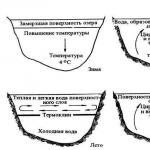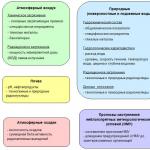This would seem to be the translation decimal in the usual - an elementary topic, but many students do not understand it! Therefore, today we will take a detailed look at several algorithms at once, with the help of which you will understand any fractions in just a second.
Let me remind you that there are at least two forms of writing the same fraction: common and decimal. Decimal fractions are all kinds of constructions of the form 0.75; 1.33; and even −7.41. Here are examples of ordinary fractions that express the same numbers:
Now let's figure it out: how to move from decimal notation to regular notation? And most importantly: how to do this as quickly as possible?
Basic algorithm
In fact, there are at least two algorithms. And we'll look at both now. Let's start with the first one - the simplest and most understandable.
To convert a decimal to a fraction, you need to follow three steps:
An important note about negative numbers. If in the original example there is a minus sign in front of the decimal fraction, then in the output there should also be a minus sign in front of the ordinary fraction. Here are some more examples:
 Examples of transition from decimal notation of fractions to ordinary ones
Examples of transition from decimal notation of fractions to ordinary ones I would like to pay special attention to the last example. As you can see, the fraction 0.0025 contains many zeros after the decimal point. Because of this, you have to multiply the numerator and denominator by 10 as many as four times. Is it possible to somehow simplify the algorithm in this case?
Of course you can. And now we will look at an alternative algorithm - it is a little more difficult to understand, but after a little practice it works much faster than the standard one.
Faster way
This algorithm also has 3 steps. To get a fraction from a decimal, do the following:
- Count how many digits are after the decimal point. For example, the fraction 1.75 has two such digits, and 0.0025 has four. Let's denote this quantity by the letter $n$.
- Rewrite the original number as a fraction of the form $\frac(a)(((10)^(n)))$, where $a$ are all the digits of the original fraction (without the “starting” zeros on the left, if any), and $n$ is the same number of digits after the decimal point that we calculated in the first step. In other words, you need to divide the digits of the original fraction by one followed by $n$ zeros.
- If possible, reduce the resulting fraction.
That's all! At first glance, this scheme is more complicated than the previous one. But in fact it is both simpler and faster. Judge for yourself:
As you can see, in the fraction 0.64 there are two digits after the decimal point - 6 and 4. Therefore $n=2$. If we remove the comma and zeros on the left (in this case, just one zero), we get the number 64. Let’s move on to the second step: $((10)^(n))=((10)^(2))=100$, Therefore, the denominator is exactly one hundred. Well, then all that remains is to reduce the numerator and denominator. :)
One more example:
Here everything is a little more complicated. Firstly, there are already 3 numbers after the decimal point, i.e. $n=3$, so you have to divide by $((10)^(n))=((10)^(3))=1000$. Secondly, if we remove the comma from the decimal notation, we get this: 0.004 → 0004. Remember that the zeros on the left must be removed, so in fact we have the number 4. Then everything is simple: divide, reduce and get the answer.
Finally, the last example:
The peculiarity of this fraction is the presence of a whole part. Therefore, the output we get is an improper fraction of 47/25. You can, of course, try to divide 47 by 25 with a remainder and thus again isolate the whole part. But why complicate your life if this can be done at the stage of transformation? Well, let's figure it out.
What to do with the whole part
In fact, everything is very simple: if we want to get a proper fraction, then we need to remove the whole part from it during the transformation, and then, when we get the result, add it again to the right before the fraction line.
For example, consider the same number: 1.88. Let's score by one (the whole part) and look at the fraction 0.88. It can be easily converted:
Then we remember about the “lost” unit and add it to the front:
\[\frac(22)(25)\to 1\frac(22)(25)\]
That's all! The answer turned out to be the same as after selecting the whole part last time. A couple more examples:
\[\begin(align)& 2.15\to 0.15=\frac(15)(100)=\frac(3)(20)\to 2\frac(3)(20); \\& 13.8\to 0.8=\frac(8)(10)=\frac(4)(5)\to 13\frac(4)(5). \\\end(align)\]
This is the beauty of mathematics: no matter which way you go, if all the calculations are done correctly, the answer will always be the same. :)
In conclusion, I would like to consider one more technique that helps many.
Transformations “by ear”
Let's think about what a decimal even is. More precisely, how we read it. For example, the number 0.64 - we read it as "zero point 64 hundredths", right? Well, or just “64 hundredths”. The key word here is “hundredths”, i.e. number 100.
What about 0.004? This is “zero point 4 thousandths” or simply “four thousandths”. Anyway, keyword- “thousandths”, i.e. 1000.
So what's the big deal? And the fact is that it is these numbers that ultimately “pop up” in the denominators at the second stage of the algorithm. Those. 0.004 is “four thousandths” or “4 divided by 1000”:
Try to practice yourself - it's very simple. The main thing is to read the original fraction correctly. For example, 2.5 is “2 whole, 5 tenths”, so
And some 1.125 is “1 whole, 125 thousandths”, so
In the last example, of course, someone will object that it is not obvious to every student that 1000 is divisible by 125. But here you need to remember that 1000 = 10 3, and 10 = 2 ∙ 5, therefore
\[\begin(align)& 1000=10\cdot 10\cdot 10=2\cdot 5\cdot 2\cdot 5\cdot 2\cdot 5= \\& =2\cdot 2\cdot 2\cdot 5\ cdot 5\cdot 5=8\cdot 125\end(align)\]
Thus, any power of ten is decomposed only into factors 2 and 5 - it is these factors that need to be looked for in the numerator, so that in the end everything is reduced.
This concludes the lesson. Let's move on to a more complex reverse operation - see "
A large number of students, and not only, are wondering how to convert a fraction into a number. To do this, there are several fairly simple and understandable ways. The choice of a specific method depends on the preferences of the decider.
First of all, you need to know how fractions are written. And they are written as follows:
- Ordinary. It is written with the numerator and denominator using a slant or a column (1/2).
- Decimal. It is written separated by commas (1.0, 2.5, and so on).
Before you start solving, you need to know what an improper fraction is, because it occurs quite often. It has a numerator greater than the denominator, for example, 15/6. Improper fractions can also be solved in these ways, without any effort or time.
A mixed number is when the result is a whole number and a fractional part, for example 52/3.
Any natural number can be written as a fraction with completely different natural denominators, for example: 1= 2/2=3/3 = etc.
You can also translate using a calculator, but not all of them have this function. There is a special engineering calculator that has such a function, but it is not always possible to use it, especially at school. Therefore, it is better to understand this topic.
The first thing you should pay attention to is what fraction it is. If it can be easily multiplied up to 10 by the same values as the numerator, then you can use the first method. For example: you multiply an ordinary ½ in the numerator and denominator by 5 and get 5/10, which can be written as 0.5.
This rule is based on the fact that a decimal always has a round value in its denominator, such as 10,100,1000, and so on.
It follows from this that if you multiply the numerator and the denominator, then you need to achieve exactly the same value in the denominator as a result of the multiplication, regardless of what comes out in the numerator.
It is worth remembering that some fractions cannot be converted; to do this, you need to check it before starting the solution.
For example: 1.3333, where the number 3 is repeated ad infinitum, and the calculator will not get rid of it either. The only solution to this problem is to round it to a whole number, if possible. If this is not possible, then you should return to the beginning of the example and check the correctness of the solution to the problem; perhaps an error was made.

Figure 1-3. Converting fractions by multiplication.
To consolidate the described information, consider the following translation example:
- For example, you need to convert 6/20 to a decimal. The first step is to check it, as shown in Figure 1.
- Only after you are convinced that it can be decomposed, as in this case into 2 and 5, should you begin the translation itself.
- The simplest option would be to multiply the denominator to get a result of 100, which is 5, since 20x5=100.
- Following the example in Figure 2, the result will be 0.3.
You can consolidate the result and review everything again according to Figure 3. In order to fully understand the topic and no longer resort to studying this material. This knowledge will help not only the child, but also the adult.
Translation by division
The second option for converting fractions is a little more complicated, but more popular. This method is mainly used by teachers in schools to explain. Overall, it is much easier to explain and quicker to understand.
 It is worth remembering that to correctly convert a simple fraction, you must divide its numerator by its denominator. After all, if you think about it, the solution is the process of division.
It is worth remembering that to correctly convert a simple fraction, you must divide its numerator by its denominator. After all, if you think about it, the solution is the process of division.
In order to understand this simple rule, you need to consider the following example solution:
- Let's take 78/200, which needs to be converted to decimal. To do this, divide 78 by 200, that is, the numerator by the denominator.
- But before you start, it's worth checking, as shown in Figure 4.
- Once you are convinced that it can be solved, you should begin the process. To do this, divide the numerator by the denominator in a column or corner, as shown in Figure 5. B primary school schools teach this division, and there should be no difficulties with it.
Figure 6 shows examples of the most common examples; you can simply remember them so that, if necessary, you do not waste time solving them. After all, at school, for every test or independent work Little time is given to solve, so you shouldn’t waste it on something that you can learn and simply remember.
Interest transfer
 Convert interest to decimal number also quite easy. This begins to be taught in the 5th grade, and in some schools even earlier. But if your child did not understand this topic during a math lesson, you can clearly explain it to him again. First, you should learn the definition of what a percentage is.
Convert interest to decimal number also quite easy. This begins to be taught in the 5th grade, and in some schools even earlier. But if your child did not understand this topic during a math lesson, you can clearly explain it to him again. First, you should learn the definition of what a percentage is.
A percentage is one hundredth of a number; in other words, it is completely arbitrary. For example, from 100 it will be 1 and so on.
Figure 7 shows a clear example of interest conversion.
To convert a percentage, you just need to remove the % sign and then divide it by 100.
Another example is shown in Figure 8.
If you need to carry out a reverse “conversion”, you need to do everything exactly the opposite. In other words, the number must be multiplied by one hundred and then a percentage symbol must be added.
And in order to convert the usual into percentages, you can also use this example. Only initially should you convert the fraction into a number and only then into a percentage.
Based on the above, you can easily understand the principle of translation. Using these methods, you can explain a topic to a child if he did not understand it or was not present in the lesson at the time of its completion.
And there will never be a need to hire a tutor to explain to your child how to convert a fraction into a number or percentage.
A fraction can be converted to a whole number or to a decimal. An improper fraction, the numerator of which is greater than the denominator and is divisible by it without a remainder, is converted to a whole number, for example: 20/5. Divide 20 by 5 and get the number 4. If the fraction is proper, then there is a numerator less than the denominator, then convert it to a number (decimal fraction). You can get more information about fractions from our section -.
Ways to convert a fraction to a number
- The first way to convert a fraction into a number is suitable for a fraction that can be converted to a number that is a decimal fraction. First, let's find out whether it is possible to convert the given fraction to a decimal fraction. To do this, let's pay attention to the denominator (the number that is below the line or to the right of the sloping line). If the denominator can be factorized (in our example - 2 and 5), which can be repeated, then this fraction can actually be converted into a final decimal fraction. For example: 11/40 =11/(2∙2∙2∙5). This common fraction will be converted to a number (decimal) with a finite number of decimal places. But the fraction 17/60 =17/(5∙2∙2∙3) will be converted into a number with an infinite number of decimal places. That is, when accurately calculating a numerical value, it is quite difficult to determine the final decimal place, since there are an infinite number of such signs. Therefore, solving problems usually requires rounding the value to hundredths or thousandths. Next, you need to multiply both the numerator and the denominator by such a number so that the denominator produces the numbers 10, 100, 1000, etc. For example: 11/40 = (11∙25)/(40∙25) = 275/1000 = 0.275
- The second way to convert a fraction into a number is simpler: you need to divide the numerator by the denominator. To apply this method, we simply perform division, and the resulting number will be the desired decimal fraction. For example, you need to convert the fraction 2/15 into a number. Divide 2 by 15. We get 0.1333... - infinite fraction. We write it like this: 0.13(3). If the fraction is an improper fraction, that is, the numerator is greater than the denominator (for example, 345/100), then converting it to a number will result in a whole number value or a decimal fraction with a whole fractional part. In our example it will be 3.45. To convert mixed fraction such as 3 2 / 7 into a number, then you must first turn it into an improper fraction: (3∙7+2)/7 =23/7. Next, divide 23 by 7 and get the number 3.2857143, which we reduce to 3.29.
The easiest way to convert a fraction into a number is to use a calculator or other computing device. First we indicate the numerator of the fraction, then press the button with the “divide” icon and enter the denominator. After pressing the "=" key, we get the desired number.
Simple fractions are not always easy to use. You can’t insert them into a report or statement, and modern computer programs are not always friendly with such numbers. Converting a fraction to (or to a decimal) is not difficult.
You will need
- piece of paper, pen, calculator
Instructions
Converting a fraction to a number means dividing the numerator by the denominator. The numerator is the top part of the fraction, the denominator is the bottom. If you have a calculator at hand, then press the buttons and the task is completed. The result will be either a whole number or a decimal fraction. A decimal fraction may have a long remainder after the decimal point. In this case, the fraction must be rounded to the specific digit you need, using the rounding rules (numbers up to 5 are rounded down, from 5 inclusive and more - up).
If you don’t have a calculator at hand, you will have to divide into a column. Write the numerator of the fraction next to the denominator, with a small corner between them indicating division. For example, convert the fraction 10/6 to a number. First, divide 10 by 6. You get 1. Write the result in a corner. Multiply 1 by 6, you get 6. Subtract 6 from 10. You get a remainder of 4. The remainder must be divided by 6 again. Add the number 0 to 4, and divide 40 by 6. You get 6. Write 6 in the result, after the decimal point. Multiply 6 by 6. You get 36. Subtract 36 from 40. The remainder is again 4. You don’t need to continue further, since it becomes obvious that the result will be the number 1.66(6). Round this fraction to the digit you need. For example, 1.67. This is the final result.
Algebra and mathematics are complex sciences that are not easy even for those who devote a lot of time to them. Problems can arise with any task. For example, not everyone knows how to convert a decimal fraction to common fraction.
Features of fractions
To easily convert one type of fraction to another, it is best to understand what it is. They can be called a non-integer number. It consists of one or more parts of the unit.
First of all, ordinary or so-called simple fractions are distinguished. For any type, the rule is that the denominator cannot be zero. If this is true, then this means that the value is an integer, that is, it cannot be a fraction.
There are several types of writing this number. A horizontal line or a slash is used, and the latter option can appear in print in three different ways. IN school notebooks As a rule, ordinary fractions are written with a classic horizontal line.
In addition to simple fractions, mixed and compound fractions are distinguished. The first ones differ in that they also have an integer written at the beginning. In composites, the numerator and denominator seem to also be another fraction.

How to convert a decimal fraction to a fraction?
Converting a decimal fraction into a regular fraction is not so difficult, since, despite external changes, the essence of the number will remain the same. The key difference is that decimals are written using commas, not a dash. Of course, this does not mean that the fraction ½ will equal 1.2.
A decimal fraction is formed from two components. The first is located before the sign and denotes an integer. The second, the one after it, is tenths, hundredths and other numbers. Their name depends on how far they are from the comma.
Sometimes it's very easy to convert one fraction into another, especially if the non-integer part is tenths rather than hundredths or thousandths. Classic example–0.5. First of all, you should read it correctly, then you will get zero point five. There is no way to write zero whole numbers, but five tenths easily turns into 5/10. All that remains is to make the reduction by dividing by five. The result is ½.
Fraction with a whole number
It is necessary to consider other examples with increased complexity. It's worth taking 2.25. As before, to begin with, it is best to correctly indicate the name of the fraction. This time there are two point twenty five hundredths. Due to the fact that there are two digits after the sign, they are hundredths.
How to convert a decimal fraction to a fraction:
- The non-integer part is written as 25/100.
- It remains to add two integers. They are placed at the beginning, and thus a mixed fraction is obtained.
- 25/100 can be reduced. For simplicity, it's practical to start by dividing by 5, but it's a good idea to go straight to 25. The reduction results in ¼.
- All that remains is to sign two integers to ¼. The result is 2 ¼.
Finally, it is worth considering the process of working with thousandths. For analysis, let's take 4.112. Again, the work must begin with the correct reading. It turns out to be four point one hundred twelve thousandths. You can easily isolate the first digit, 4, and then substitute one hundred and twelve thousandths to it. They look like this - 112/100.
All that's left to do is cut it down to give it a better look. In that specific example the common divisor is six. The result is a simple fraction 4 14/125.

Converting fractions to percentages
Almost any fraction can be easily converted into a percentage. To do this, you need to understand that percent is one hundredth. In other words, 1% can immediately be easily written in fractional form - 1/100 or 0.01.
In the case of other options, you will have to turn to decimal fractions, that is, those written separated by commas. With them the problem is solved very simply. It is enough to multiply the decimal fraction by 100, and you will get the desired percentage.
- 0,27 * 100% = 27%
If it is necessary to convert an ordinary fraction, then first it will have to be converted to a decimal.
- For example, 2/5 equals 0.4.
- 0,4 * 100% = 40%.
If the process of converting to percentages still causes difficulties, then, if desired, you can use various automatic services, of which there are quite a few on the Internet. By entering the numerator and denominator in the appropriate fields, you can easily find out what the percentage will be.
In general, converting fractions to percentages always involves multiplying by 100. In order to easily cope with this, you need to understand how to convert a common fraction to a decimal, but first, it’s worth understanding the reverse process.

Video instruction




